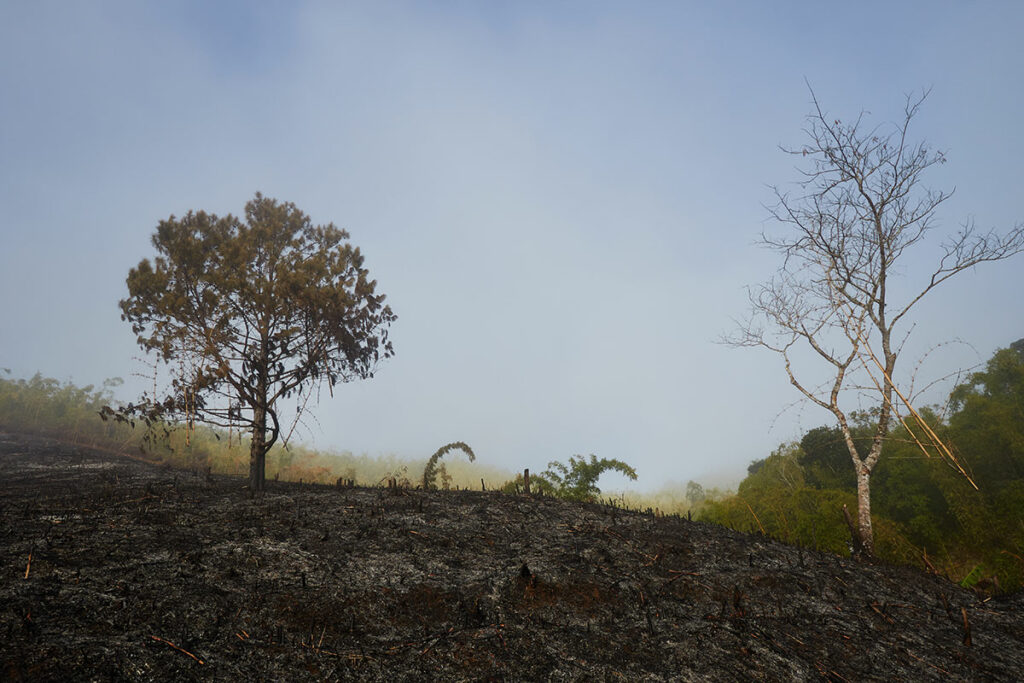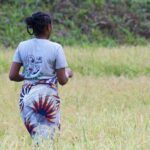Everything started in November 2008, while the greater bamboo lemur population was then estimated at less than 100 individuals in Madagascar.

An expedition organized by the Centre ValBio and the Association “Madagascar National Parks”, funded by Cotswold Wildlife Park, went to Miaranony (estearn Ranomafana National Park) to check the presence (or the absence) of greater bamboo lemurs in the area. Indeed, observations made in 2001 reported that one group of Prolemur simus was living there. In 2007, only a few tracks were identified but they couldn’t be attributed to greater bamboo lemurs with certainty at that time.
On their way back after this new unsuccessful exploration, the team conducted by Dr. Anna Feistner (Director of Centre ValBio) et Mr. Mamy Rakotoarijaona (Director of Ranomafana National Park) came across a group of about ten greater bamboo lemurs near the village of Vohitrarivo located on Tsaratanana rural town (Feistner, 2009). The Bamboo Lemur programme was born!
In 2009 several surveys were organized in the same area. A second group of greater bamboo lemurs was found in Vohimarina. These two groups respectively included 23 and 24 individuals. In late autumn 2009, thanks to several births, these groups had reached nearly 30 individuals each. They were the largest groups of greater bamboo lemur ever observed in the wild. In December 2009, a third group was discovered in Sahofika, with about 20 animals. In total, nearly 80 animals began to be regularly monitored by the staff from Centre ValBio and Madagascar National Parks, assisted by local guides recruited in nearby villages.
In November 2010, 14 babies were recorded within the two groups of Vohitrarivo and Vohimarina. In late 2013, 10 babies were observed in group II living close to the village of Vohitrarivo. This group included more than 60 individuals, being the largest group ever observed in the wild at that time!

Today the programme Bamboo lemur protects more than 600 greater bamboo lemurs. 10 groups have been identified and are daily monitored by a team of about 40 local guides. The size of these groups (more than 20 individuals on average) gives them a major scientific interest, the biology of the species (feeding behavior, reproduction, social organization, home range…) still being little known .
The funds raised by Helpsimus are given to the Bamboo Lemur programme which aims to protect the population of greater bamboo lemurs that lives in the periphery of Ranomafana National Park, yet outside its protected area.


These animals live in degraded bamboo forests and are regularly found near the villages, sometimes feeding on sugar cane, lychees, rice and bamboo cultivated by farmers.
Protecting this population is essential to the survival of the species. The monitoring of the animals is entirely funded by Helpsimus and helps us to better understand their biology. Thanks to the data collected, effective conservation actions can be implemented and the breeding of the species in captivity can also be improved.
The Bamboo Lemur programme, initiated by Dr. Anna Feistner and Mamy Rakotoarijaona (Ranomafama National Park), is is a quadripartite project that brings together local Malagasy stakeholders (villagers, agents of the National Park of Ranomafana, the NGO IMPACT Madagascar) and Helpsimus who define the list of priority actions together. It is supported by the EEP and the EAZA Prosimian Taxonomy Advisory Group.
While the greater bamboo lemur is protected against hunting by local tradition, its habitat is threatened by the expansion of agriculture.

In addition, bamboo -the main food source of the species- is widely used by the villagers for building their houses, their furniture or their fishing equipment… These rural communities are very poor and highly dependent on natural resources. The Bamboo Lemur programme supports socio-economic and socio-cultural studies to better understand and assess the needs of the villagers, in order to implement development actions. The programme thus contributes to the construction of drinking water fountains, women’s association providing health and hygiene education, community attics, bridges… The programme also helps create alternative solutions to slash-and-burn agriculture, a widespread practice throughout the island of Madagascar with dramatic consequences for the environment. It indeed generates irreversible soil depletion and consequently a continued expansion of agricultural land at the cost of the greater bamboo lemur habitat and more generally of the biodiversity. The Bamboo Lemur programme helps implementing a sustainable management of natural resources, including sustainable alternatives to slash-and-burn agriculture.

But the Bamboo Lemur programme has also made education a priority. Teachers, whose numbers have been reinforced, and community leaders are made aware of environmental protection issues. Environmental activities are initiated in the villages surrounding the areas where greater bamboo lemurs are found thanks to the creation of the Simus School dedicated to environmental education. The project also constructed several classrooms and regularly sends educational materials to the local schools.


Raising awareness of local population about the conservation of the greater bamboo lemur and its habitat is indeed crucial if we want to ensure both the sustainability of the programme and the survival of the species. Valuing the presence of greater bamboo lemurs with the villagers and involving them in their protection can help reduce the human pressure on the environment. Since 2008, much has been achieved in the fokontany of Vohitrarivo, Ambodimanga, Ambohipo, Volotara and Sahofika. However, much remains to be done. This is why we need your support!






